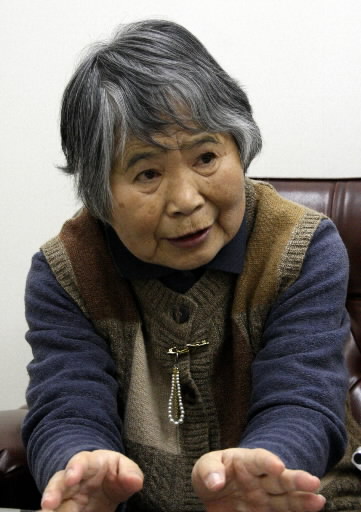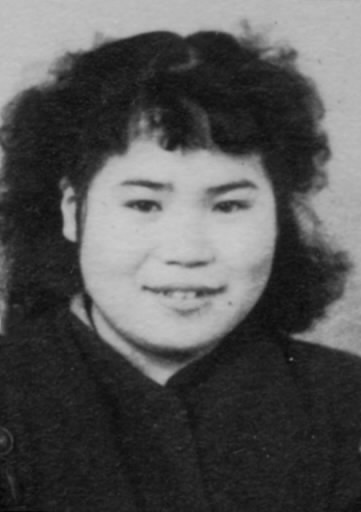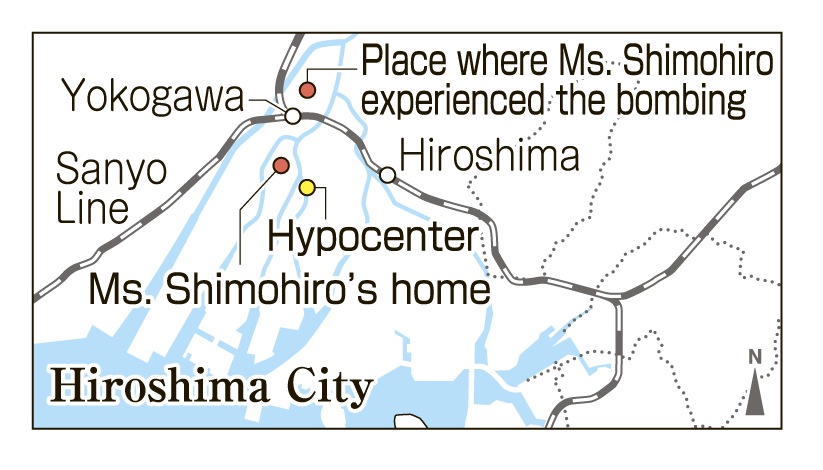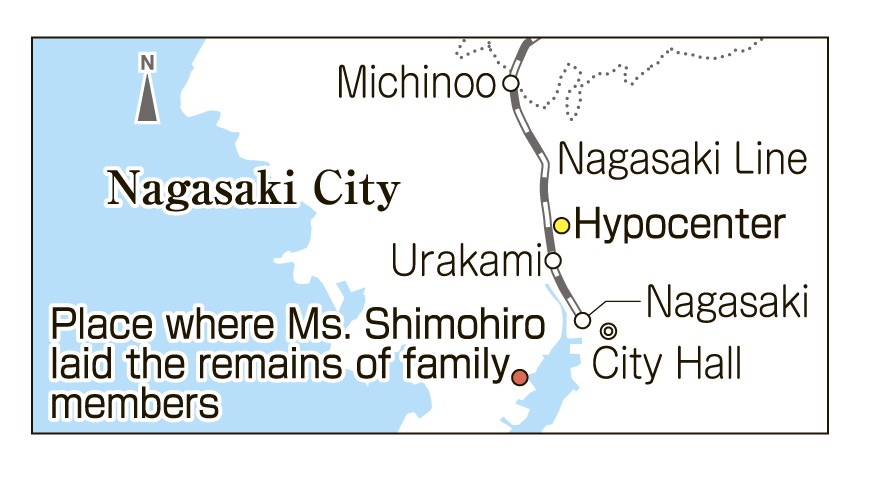Narumi Shimohiro, 79, Asakita Ward, Hiroshima
Aug. 7, 2012
Agony of suffering both atomic bombings
Family remains brought to Nagasaki / Contemplated suicide at grave site
“Why did I have to experience such a terrible thing twice?” Narumi Shimohiro (nee Watanabe) is now 79 years old. With her eyes cast down and filling with tears, she slowly spoke about the day the atomic bomb was dropped on the city of Hiroshima.
On August 6, 1945, Ms. Shimohiro experienced the atomic bombing while in Misasa-honmachi (part of present-day Nishi Ward), about 2 kilometers from the hypocenter. Her mother Yae, then 38, her younger sister Tamie, 3, and her great-grandmother Sawa, 86, all perished in the blast. On August 15, Ms. Shimohiro and her elder sister Misako, then 15, traveled to the city of Nagasaki to bring their remains to the family grave. While in Nagasaki, they were confronted by the radiation from the second atomic bomb, which had been dropped on Nagasaki on August 9.
On the morning of August 6, Ms. Shimohiro, who was a first-year student in junior high school, was on her way to Hirose National School from her home in Hirose-motomachi, located about 900 meters from the hypocenter, to work for the war effort as a mobilized student. However, when she arrived at the school and it looked empty, she hurried on to a factory in Misasa-honmachi, the site of her work assignment. When the atomic bomb exploded, the building came down on top of her, but a man helped pull her out from under the wreckage.
She headed for home, and reached as far as the Yokogawa district, but fierce fire prevented her from getting any closer. She feared that her mother, younger sister, and great-grandmother might have died in the disaster. Meanwhile, she came across classmates who had suffered severe burns and injuries. One close friend, burned badly, passed away while uttering these last words to Ms. Shimohiro: “Live a long life for me.”
One year before the bombing, Ms. Shimohiro’s father, Fujiichi, had been transferred from the Nagasaki shipyard of Mitsubishi Heavy Industries to the Hiroshima shipyard, and her whole family moved to Hiroshima.
In the aftermath of the blast, she didn’t know what had become of her father and elder sister. Two days later, on August 8, she was reunited with them near her house. On the site of the burned rubble, where the house had stood, they dug out the remains of her mother, her younger sister, and her great-grandmother.
On the morning of August 15, Ms. Shimohiro boarded a train with her elder sister, carrying the remains of the three lost family members. Bound for Nagasaki, they were forced to get off the train two stops before the city’s main train station. Disembarking at Michinoo station, they walked across the hypocenter area to reach the Iwasemichi district, where the family grave was located. After returning to Hiroshima, they suffered complete hair loss and continuous vomiting as a result of the radiation they were exposed to in Hiroshima and Nagasaki.
“I hate the United States,” Ms. Shimohiro said. “The hatred I feel will never go away.” When she was young, a boyfriend’s parents told her: “Because you’re an atomic bomb survivor, you shouldn’t get married.” Hearing this, she thought of committing suicide at the family grave in Nagasaki. “I didn’t have a single good thing in my life back then,” she recalled.
She has spoken little about her past to others. “But the fact that I’ve survived means that I have to convey my A-bomb experience to the next generation.” She hopes that the younger generation will make an effort to form friendships with others so that ill will can be overcome. (Rie Nii, Staff Writer)
Hiroshima Insight: Atomic bombing of Nagasaki
A death toll of more than 70,000
Three days after an atomic bomb was dropped on Hiroshima, the city of Nagasaki was attacked with a second atomic bomb on August 9, 1945 at 11:02 a.m.
The bomb dropped on Nagasaki was originally intended for another target, the city of Kokura in northern Kyushu. However, because of poor visibility above Kokura--mainly caused by smoke from an air raid on August 8, the day before the attack--the B-29 bomber carrying the atomic bomb changed course and flew on to the secondary target, Nagasaki.
The target within the city was a point between the Nigiwai Bridge and the Tokiwa Bridge, which cross the Nakajima River as it flows through downtown Nagasaki. Although clouds above the city made the target hard to spot, when the chimney of a factory was glimpsed through a momentary break in the clouds, the atomic bomb was dropped.
The bomb exploded at a height of about 500 meters about the Matsuyama town, roughly 3 kilometers to the northeast of the target. According to the Nagasaki Peace Museum, by the end of 1945 the death toll was 73,884.
As of the end of February 2012, the Hiroshima National Peace Memorial Hall for the Atomic Bomb Victims indicates that, among a total of 133,045 A-bomb accounts, 306 of these accounts are concerned with suffering exposure to the atomic bombings of both Hiroshima and Nagasaki.
Teenagers' Impressions
Facing a friend’s death
As I looked at Ms. Shimohiro, speaking to us in tears, I felt the horror of the atomic bombing. Her friend’s last words, “Live a long life for me,” were very painful to hear. If I were her, I thought, I would have felt overwhelmed. She told us she still hates the United States because of what happened. I want to convey the message that we mustn’t feel hatred for one another. (Kantaro Matsuo,13)
Horror that takes away life’s meaning
It was painful for me to hear her say that it would have been better if she had died. I realized that a nuclear weapon not only deprives people of their lives, it also makes people regret that they survived. I thought it’s important for me to remember her story and convey to others how dangerous nuclear weapons are. (Shoko Kitayama,15)
Staff Writer’s Notebook
When Ms. Shimohiro first began to speak about the day of the atomic bombing, her tears flowed and she wasn’t able to continue. But she said, “I’ll do it for the children,” and she went on.
On the morning of August 6, Ms. Shimohiro thought she was late for work, and so she hurried on to the factory where she had been mobilized for the war effort. As a result, she managed to survive. Many of her classmates, who were still at school at the time, perished in the explosion. “Why didn’t I wait at school, like everyone else?” she wondered. “Why did I go ahead by myself to the factory?” When she added, “That was unfair of me,” I sensed the depth of her guilt and I felt the pain behind her words.
“I never want young people today to die in such a cruel way,” she said. Then, blurting out a sentiment that seemed to have been hidden in a dark corner of her mind, she continued: “I hate the United States. The hatred I feel will never go away.”
Ms. Shimohiro is against restarting Japan’s idle nuclear power plants, saying, “It’s scary. We don’t know what can happen.” She went on, recalling younger days: “When I was a child, our energy was generated from the wind and water and thermal power. We didn’t feel a lack of energy then. We don’t need to use nuclear energy.” Coming from a person who has survived the pain and hardship of two nuclear disasters, her words touch the heart. (Rie Nii)
(Originally published on April 10, 2012)











